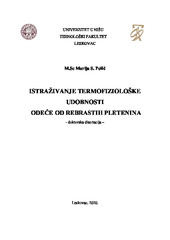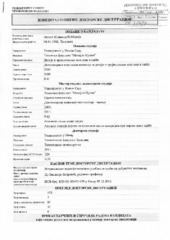Приказ основних података о дисертацији
Istraživanje termofiziološke udobnosti odeće od rebrastih pletenina
| dc.contributor.advisor | Petrović, Vasilije | |
| dc.contributor.other | Stepanović, Jovan | |
| dc.contributor.other | Trajković, Dušan | |
| dc.contributor.other | Ćirković, Nenad | |
| dc.contributor.other | Šarac, Tatjana | |
| dc.creator | Pešić, Marija S. | |
| dc.date.accessioned | 2021-03-23T10:02:40Z | |
| dc.date.available | 2021-03-23T10:02:40Z | |
| dc.date.issued | 2020-10-23 | |
| dc.identifier.uri | http://eteze.ni.ac.rs/application/showtheses?thesesId=7993 | |
| dc.identifier.uri | https://fedorani.ni.ac.rs/fedora/get/o:1685/bdef:Content/download | |
| dc.identifier.uri | http://vbs.rs/scripts/cobiss?command=DISPLAY&base=70052&RID=26372361 | |
| dc.identifier.uri | https://nardus.mpn.gov.rs/handle/123456789/18152 | |
| dc.description | The industrial development of apparel production is increasingly digitized and is increasingly moving towards meeting the specific requirements of individuals for comfortable clothing. Therefore, the developmental research was carried out in this thesis where the scientific methods were systematically applied in design and development of methods for testing the thermofphysiological comfort of RIB knitwear. The research was conducted in order to determine the relationship between the parameters of certain knitted structures and the feeling of thermophysiological comfort of the garments made from these knitwear. The parameters that were analyzed are: yarn, knitwear, finishing, physical activity and environment where the knitwear was pleaced.In the experimental part of the thesis the samples of fish knitwear were designed and made, testing of these samples was carried out, the testing method of thermophysiological comfort was developed and the testing was performed according to this method.In order to define the objective of this thesis, the real problems in the industrial production of medium-weight RIB knitwear structures for next to skin clothes, were used. The research is based on carefully designed knit samplesmade from single combed cotton yarns of different finenesses 12, 14, 17 and 20 tex.Beside this cotton yarns, the second group of samples were knitted with added 4% of elastane fibers. The range of yarns linear densities of and raw composition was carefully chosen, taking into account the market relevance of the samples that were tested.All samples were knitted in the weft 1x1 rib knit construction made on a circular knitting machine fineness E18. Raw knitwear has been dyed and bleached under industrial conditions and samples for testing and sewing garments have been extracted from these knitwear. Examination of samples was conducted in the following five sections as follows: testing of yarn parameters, testing of knitwear structural properties, testing of knitwear physical properties, testing of thermal characteristics on KES FB 7 Thermo Labo measuring device and testing of thermal characteristic and subjective method of t-shirt testing person evaluation in chamber and in the environment.The obtained test results indicate that some of the yarn and knitwear properties significantly influence on the change in the heat and water vapor resistance. These are, for yarns: different linear densities, and for knitwear: mass per unit area, thickness, linear coefficient of fullness, surface and volume and tightness factor. Adding a 4% of elastane filaments to the knitwear structure reduces the knitwear's heat and water vapor resistance. Differences in the heat and water vapor resistance of knitwear were observed in both the unwashed and washed the same type of samples.The obtained results of clothing comfort evaluation by developed both subjective and objective measuring methods of heat and water vapor resistance indicate that there is existence of large interconnection.Therefore, it can be concluded that quality analysis of the properties and thermophysiological comfort of ribbed knitwear can only be done by a systematic scientific approach, which involves measuring a large number of parameters in the process of making garments from yarn, through knitting, finishing and sewing garments. Reliable results are only obtained by carefully designing and testing non-commercial samples that can meet consumer demands. The research and results obtained in this dissertation extend the current knowledge in this field by defining, describing and classifying the elements of the connection between the thermophysiological properties of a garment and the parameters of textile materials used for its production. This gives the possibility that based on the obtained results, similarly knit structures with predetermined parameters of thermophysiological comfort and product properties can be predicted and designed in advance. | en |
| dc.format | application/pdf | |
| dc.language | sr | |
| dc.publisher | Универзитет у Нишу, Технолошки факултет, Лесковац | sr |
| dc.relation | info:eu-repo/grantAgreement/MESTD/Technological Development (TD or TR)/34020/RS// | |
| dc.rights | openAccess | en |
| dc.rights.uri | https://creativecommons.org/licenses/by-nc-nd/4.0/ | |
| dc.source | Универзитет у Нишу | sr |
| dc.subject | rebraste pletenine | sr |
| dc.subject | RIB knitwear | en |
| dc.subject | termofiziološka udobnost | sr |
| dc.subject | subjektivne i objektivne metode ispitivanja | sr |
| dc.subject | Termo Labo merni uređaji | sr |
| dc.subject | toplotna udobnost | sr |
| dc.subject | thermophysiological comfort | en |
| dc.subject | Subjective and objective metods of testing | en |
| dc.subject | Termo Labo measuring device | en |
| dc.subject | thermal comfort | en |
| dc.title | Istraživanje termofiziološke udobnosti odeće od rebrastih pletenina | sr |
| dc.type | PhD thesis | |
| dc.rights.license | BY-NC-ND | |
| dcterms.abstract | Петровић, Василије; Шарац, Татјана; Степановић, Јован; Ћирковић, Ненад; Трајковић, Душан; Пешић, Марија С.; Истраживање термофизиолошке удобности одеће од ребрастих плетенина; Истраживање термофизиолошке удобности одеће од ребрастих плетенина; | |
| dc.identifier.fulltext | https://nardus.mpn.gov.rs/bitstream/id/70373/Disertacija.pdf | |
| dc.identifier.fulltext | https://nardus.mpn.gov.rs/bitstream/id/70374/Pesic_Marija_S.pdf | |
| dc.identifier.rcub | https://hdl.handle.net/21.15107/rcub_nardus_18152 |



